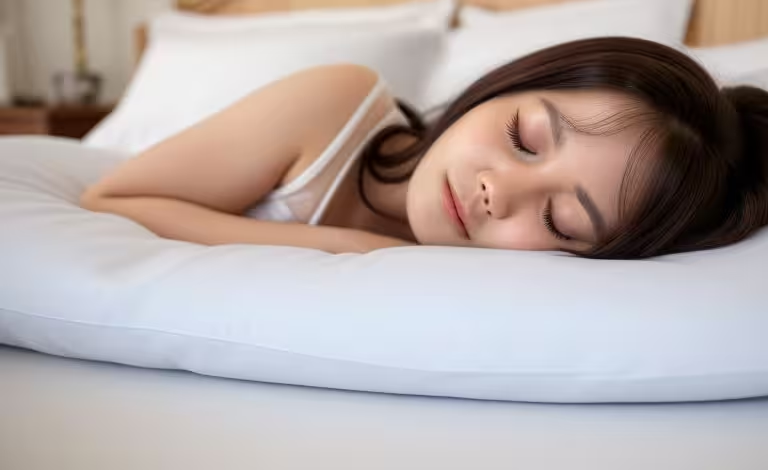Yoga for Better Sleep: 7 Relaxing Poses to Help You Sleep Like a Baby

Yoga for Better Sleep: 7 Relaxing Poses to Help You Sleep Like a Baby
In today’s fast-paced world, many people struggle with getting a good night's rest. Between the stresses of work, family, and everyday life, finding a way to calm the mind and relax the body can be a challenge. That’s where yoga comes in. Practicing yoga for better sleep can help reduce stress, calm your mind, and prepare your body for a restful night. Whether you're battling insomnia or just want to improve the quality of your sleep, incorporating yoga into your nighttime routine can make a world of difference.

In this guide, we’ll explore how yoga can help you sleep better and walk you through seven relaxing yoga poses that will have you drifting off to dreamland in no time.
How Yoga Helps Improve Sleep Quality
Yoga is a mind-body practice that combines physical postures, breathing techniques, and meditation to enhance overall well-being. When it comes to sleep, yoga offers several benefits:
1. Reduces Stress and Anxiety
Stress is one of the most common causes of sleep disturbances. Yoga helps to calm the mind and release tension in the body through controlled breathing and gentle movements. By focusing on deep, mindful breaths, yoga activates the parasympathetic nervous system, which is responsible for relaxation. This helps lower cortisol levels (the stress hormone), making it easier to unwind and fall asleep.
2. Improves Relaxation
Yoga encourages mindfulness, which helps in letting go of the worries of the day. Focusing on your breath and movements can quiet your mind, making it easier to transition into a relaxed state. This deep relaxation sets the stage for better sleep.
3. Promotes Physical Relaxation
The gentle stretching and holding of yoga poses help release tension in the muscles, especially in areas like the neck, shoulders, and back where stress tends to accumulate. By easing muscle tightness, yoga prepares the body for a more restful sleep.
4. Regulates Sleep Patterns
Practicing yoga regularly can help regulate your sleep patterns. It encourages a consistent routine, which trains your body to know when it's time to wind down and when it’s time to wake up. This can be particularly helpful for people who struggle with insomnia or irregular sleep schedules.
5. Balances the Nervous System
Yoga helps balance the autonomic nervous system, promoting relaxation and reducing the “fight-or-flight” response that often keeps people awake at night. Through a combination of breathwork and poses, yoga can soothe your nervous system and bring a sense of calm to both the body and mind.
7 Best Yoga Poses for Better Sleep
If you’re ready to start incorporating yoga into your bedtime routine, here are seven gentle, relaxing poses that are specifically designed to promote relaxation and improve sleep quality. These poses can be done in the evening, about 30 minutes before bed, to help your body and mind transition to sleep.
1. Child’s Pose (Balasana)
Child’s Pose is a deeply relaxing pose that stretches the back and hips while calming the nervous system. It’s a great pose to begin your nighttime yoga practice because it helps you connect with your breath and center your mind.
How to do it:
- Start by kneeling on the floor with your big toes touching and your knees spread apart.
- Sit back on your heels and stretch your arms forward, lowering your torso between your knees.
- Rest your forehead on the floor or on a yoga block for support.
- Breathe deeply and hold the pose for 1-3 minutes.
Benefits:
- Relieves tension in the back, shoulders, and neck
- Calms the mind and helps reduce stress
- Encourages deep, steady breathing
2. Legs Up the Wall Pose (Viparita Karani)
Legs Up the Wall Pose is an incredibly restorative pose that helps reduce fatigue, calm the mind, and promote relaxation. This pose allows the blood to flow away from your legs and feet, relieving any tension or swelling that may have accumulated throughout the day.
How to do it:
- Sit with one side of your body against the wall.
- Lie on your back and swing your legs up the wall, keeping your hips as close to the wall as is comfortable.
- Relax your arms by your sides, with palms facing up.
- Close your eyes and focus on your breathing.
- Hold this pose for 5-10 minutes.
Benefits:
- Promotes relaxation by calming the nervous system
- Reduces swelling in the legs and feet
- Relieves lower back tension
3. Reclining Bound Angle Pose (Supta Baddha Konasana)
Reclining Bound Angle Pose opens the hips and chest, encouraging deep relaxation. This pose is especially helpful for releasing tension in the lower body and is a wonderful way to stretch out before bed.
How to do it:
- Lie on your back and bring the soles of your feet together, letting your knees fall open to the sides.
- Place your arms by your sides, palms facing up.
- If your knees feel strained, place a pillow or rolled-up blanket under each knee for support.
- Close your eyes and breathe deeply.
- Hold this pose for 3-5 minutes.
Benefits:
- Gently stretches the hips, thighs, and groin
- Encourages relaxation by opening the chest and improving breathing
- Relieves stress and tension in the lower body
4. Cat-Cow Pose (Marjaryasana-Bitilasana)
Cat-Cow Pose is a gentle flowing sequence that stretches the spine and releases tension in the back and neck. This pose is ideal for unwinding after a long day and can help alleviate any physical discomfort that might prevent you from falling asleep.
How to do it:
- Start on your hands and knees, with your wrists directly under your shoulders and knees under your hips.
- Inhale as you arch your back, lifting your chest and tailbone toward the ceiling (Cow Pose).
- Exhale as you round your back, drawing your chin to your chest and tucking your tailbone (Cat Pose).
- Continue this flowing movement with your breath for 1-3 minutes.
Benefits:
- Stretches and releases tension in the spine
- Increases flexibility in the back and neck
- Promotes deep, rhythmic breathing
5. Standing Forward Bend (Uttanasana)
Standing Forward Bend is a calming pose that helps relieve tension in the back and neck while promoting blood flow to the brain. This pose can be particularly beneficial if you’ve been sitting for long periods during the day.
How to do it:
- Stand with your feet hip-width apart.
- Hinge at your hips and fold forward, reaching for your toes or letting your arms dangle toward the floor.
- Keep a slight bend in your knees to prevent strain on your lower back.
- Relax your neck and let your head hang heavy.
- Hold the pose for 1-3 minutes, breathing deeply.
Benefits:
- Calms the mind and reduces stress
- Stretches the hamstrings and lower back
- Promotes relaxation by relieving tension in the neck and shoulders
6. Seated Forward Bend (Paschimottanasana)
Similar to the standing version, Seated Forward Bend helps stretch the entire back of the body while calming the mind. It’s a great pose to do before bed to release any lingering tension in the body.
How to do it:
- Sit with your legs extended straight in front of you.
- Inhale as you lengthen your spine, then exhale as you fold forward over your legs.
- Reach for your toes, shins, or ankles, keeping your spine long.
- Relax your head and neck, and hold the pose for 3-5 minutes.
Benefits:
- Stretches the spine, hamstrings, and lower back
- Calms the mind and helps relieve anxiety
- Encourages deep, steady breathing
7. Corpse Pose (Savasana)
Corpse Pose is the ultimate relaxation pose and is often practiced at the end of a yoga session. This pose allows your body and mind to fully relax and is a perfect way to end your nighttime yoga routine.
How to do it:
- Lie flat on your back with your arms by your sides, palms facing up.
- Let your feet fall open naturally and relax your entire body.
- Close your eyes and focus on your breath, letting go of any tension.
- Stay in this pose for 5-10 minutes, allowing yourself to fully relax.
Benefits:
- Promotes deep relaxation of the body and mind
- Reduces stress and anxiety
- Helps quiet the mind before sleep
Tips for Practicing Yoga for Better Sleep
To maximize the benefits of yoga for sleep, consider these tips:
1. Practice in a Calm Environment
Find a quiet, dimly lit space where you won’t be disturbed. Turn off your phone and any other distractions to fully immerse yourself in your practice.
2. Focus on Your Breath
Breathing deeply and mindfully is a key component of yoga, especially when it comes to promoting relaxation. Focus on slow, deep breaths throughout your practice, inhaling through your nose and exhaling through your mouth.
3. Be Consistent
Like any practice, consistency is key to seeing results. Try to practice yoga for sleep every night or as often as possible. Even a short 10-15 minute session before bed can make a big difference in your sleep quality.
4. Listen to Your Body
Yoga is meant to be gentle and relaxing, so don’t push yourself too hard. Listen to your body and move at your own pace. If a pose feels uncomfortable, modify it or skip it altogether.
5. Use Props if Needed
If you find certain poses uncomfortable, use props like pillows, blankets, or yoga blocks for support. Props can help you maintain proper alignment and make poses more comfortable, allowing for deeper relaxation.
Yoga is a natural and effective way to improve your sleep quality and overall well-being. By incorporating these gentle poses into your bedtime routine, you can calm your mind, relax your body, and set the stage for a restful night of sleep. Whether you’re new to yoga or a seasoned practitioner, practicing yoga for better sleep can help you fall asleep faster, sleep more deeply, and wake up feeling refreshed.
Give these poses a try, and soon you’ll be enjoying the deep, restorative sleep you deserve. Sweet dreams!


